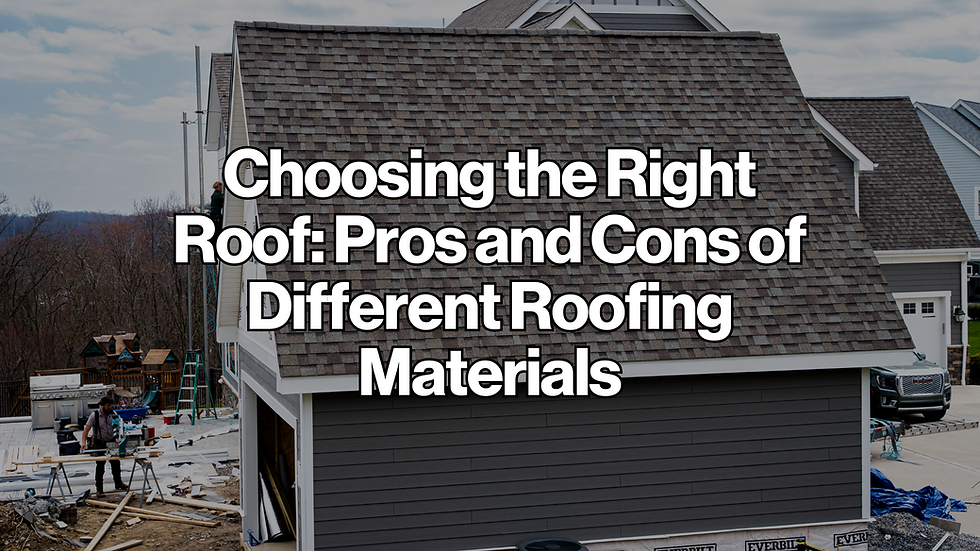Choosing the Right Roof: Pros and Cons of Different Roofing Materials
- Amanda Chute
- Mar 18, 2024
- 3 min read

Your roof is one of the most critical components of your home, providing protection from the elements and contributing to your property's overall aesthetics. When it's time to install a new roof or replace an existing one, you'll face the important decision of choosing the right roofing material. Each type of roofing material comes with its own set of advantages and disadvantages. In this guide, we'll explore the pros and cons of some common roofing materials to help you make an informed choice.
Asphalt Shingles
Pros:
- Affordability: Asphalt shingles are one of the most budget-friendly options, making them a popular choice for homeowners.
- Variety: They come in a wide range of styles and colors to suit various architectural designs.
- Easy Installation: Roofing professionals can quickly install asphalt shingles, reducing labor costs.
Cons:
- Durability: While they are reasonably durable, asphalt shingles have a shorter lifespan compared to some other materials, typically around 15 to 30 years.
- Environmental Impact: Asphalt shingles are not very eco-friendly, as they are not easily recyclable.
Metal Roofing
Pros:
- Longevity: Metal roofs can last 40-70 years or more, depending on the type of metal used.
- Durability: They are highly resistant to harsh weather conditions, including snow, rain, and wind.
- Energy Efficiency: Metal roofs often reflect sunlight, reducing cooling costs in hot climates.
Cons:
- Cost: Metal roofs can be more expensive upfront than asphalt shingles, though they may have a longer lifespan.
- Noise: Some people find metal roofs noisier during heavy rain or hailstorms.
Wood Shingles and Shakes
Pros:
- Natural Aesthetic: Wood roofing materials provide a warm, rustic look that many homeowners find appealing.
- Insulation: They offer natural insulation, helping to regulate indoor temperatures.
- Eco-Friendly: Wood is a renewable resource and can be environmentally friendly if sustainably sourced.
Cons:
- Maintenance: Wood shingles and shakes require regular maintenance to prevent issues like rot and moss growth.
- Cost: They can be more expensive than asphalt shingles, and the cost may vary based on the type of wood used.
- Fire Hazard: Wood roofing materials can be a fire hazard, though treated options are available for added fire resistance.
Slate Roofing
Pros:
- Elegance: Slate roofs are renowned for their timeless and elegant appearance.
- Longevity: They can last for over a century with proper care.
- Durability: Slate is highly durable and resistant to fire, mold, and insects.
Cons:
- Cost: Slate is one of the most expensive roofing materials, both in terms of materials and installation.
- Weight: Slate is heavy, and not all homes can support its weight without structural modifications.
- Fragility: While durable, slate can be brittle and may break if walked on.
Clay and Concrete Tiles
Pros:
- Aesthetics: These tiles provide a classic and timeless look, often associated with Mediterranean or Spanish-style homes.
- Durability: Clay and concrete tiles are highly resistant to fire, rot, and insects.
- Longevity: They can last 50-100 years or more.
Cons:
- Weight: Similar to slate, clay and concrete tiles are heavy and may require extra structural support.
- Cost: They are relatively expensive compared to asphalt shingles.
- Fragility: Like slate, these tiles can be fragile and may break if not handled carefully.
The right roofing material for your home depends on factors like your budget, climate, architectural style, and personal preferences. Consulting with a roofing professional can help you make an informed decision that ensures both the longevity and beauty of your roof. Remember that proper installation and maintenance are key to maximizing the benefits of your chosen roofing material.
.png)
Comments